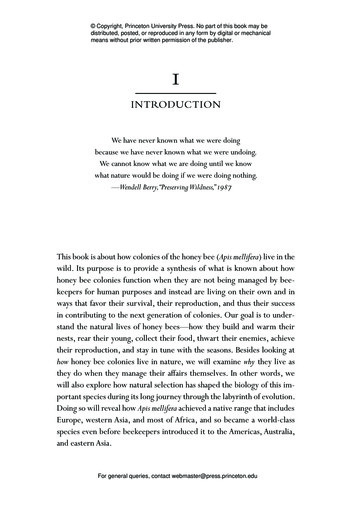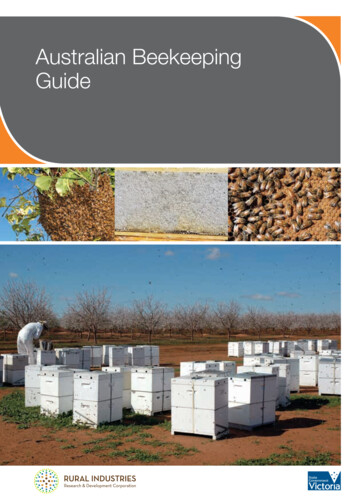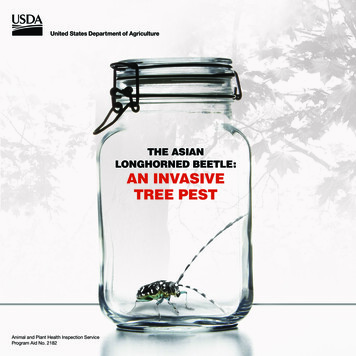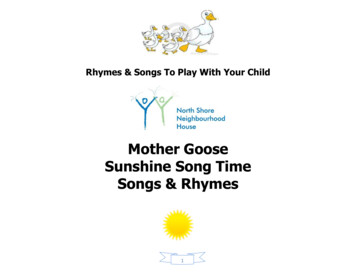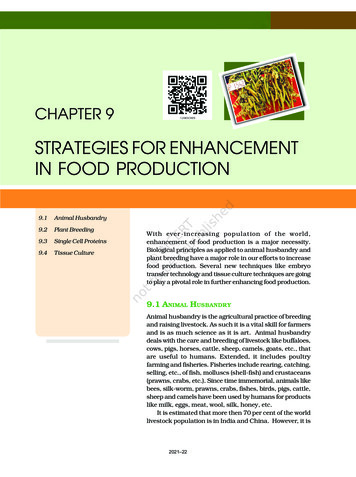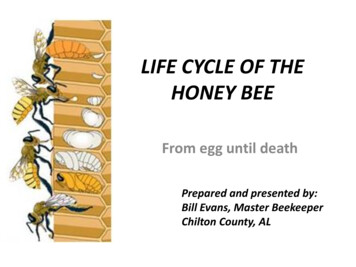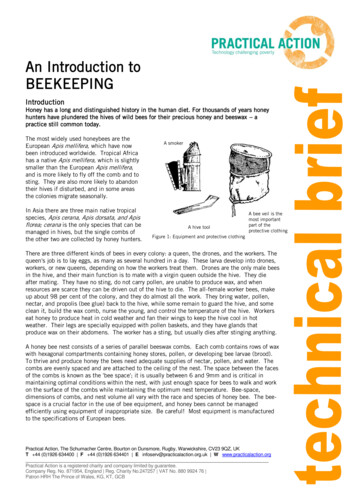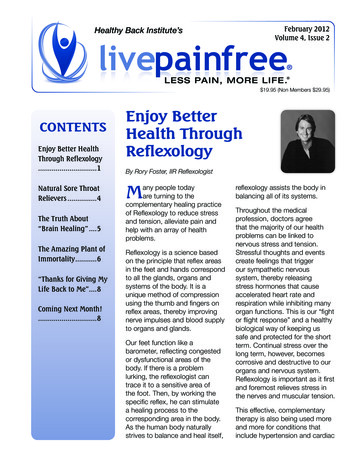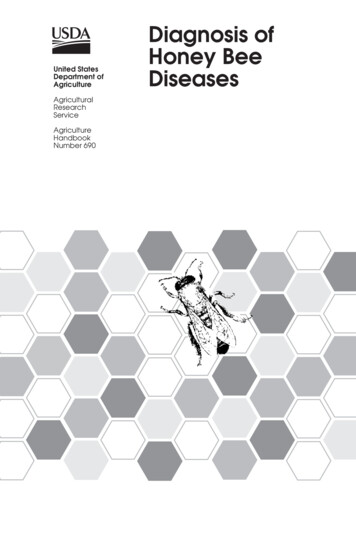
Transcription
United StatesDepartment eHandbookNumber 690Diagnosis ofHoney BeeDiseases
United StatesDepartment eHandbookNumber 690Diagnosis ofHoney BeeDiseasesHachiro Shimanuki and David A. Knox
AbstractShimanuki, Hachiro, and David A. Knox. 2000. Diagnosis of Honey BeeDiseases. U.S. Department of Agriculture, Agriculture Handbook No. AH–690, 61 pp.Apiary inspectors and beekeepers must be able to recognize bee diseasesand parasites and to differentiate the serious diseases from the lessimportant ones. This handbook describes laboratory techniques used todiagnose diseases and other abnormalities of the honey bee and to identifyparasites and pests. Emphasis is placed on the techniques used by the U.S.Department of Agriculture Bee Research Laboratory. Included aredirections for submitting, through APHIS-PPQ or state regulators, samplesof suspected Africanized honey bees for identification of subspecies. Alsoincluded are directions for sending diseased brood and adult honey beesfor diagnosis of bee disease.Keywords: Africanized honey bee, honey bee disease, honey bee disorder,honey bee parasite, honey bee pestMention of trade names, commercial products, or companies in thispublication is solely for the purpose of providing specific information anddoes not imply recommendation or endorsement by the U.S. Departmentof Agriculture over others not mentioned.While supplies last, single copies of this publication may be obtained at nocost from Bee Research Laboratory, Building 476, BARC-East, Beltsville,MD 20705.Copies of this publication may be purchased from the National TechnicalInformation Service, 5285 Port Royal Road, Springfield, VA 22161;telephone (703) 605–6000.The United States Department of Agriculture (USDA) prohibits discrimination in all its programs and activities on the basis of race, color, nationalorigin, sex, religion, age, disability, political beliefs, sexual orientation,and marital or familial status. (Not all prohibited bases apply to allprograms.) Persons with disabilities who require alternative means forcommunication of program information (Braille, large print, audiotape,etc.) should contact USDA’s TARGET Center at (202) 720–2600 (voiceand TDD).To file a complaint, write USDA, Director, Office of Civil Rights, Room326–W, Whitten Building, 1400 Independence Avenue, S.W., Washington,DC 20250-9410, or call (202) 720–5964 (voice and TDD). USDA is anequal opportunity provider and employer.Issued April 1991; revised July 2000
ContentsIntroduction . 1Symptoms . 1Bacterial Diseases . 2American Foulbrood . 2European Foulbrood . 9Powdery Scale . 12Septicemia . 13Spiroplasmosis . 13Fungal Diseases . 14Chalkbrood . 14Stonebrood . 15Protozoan Diseases . 16Nosema Disease . 16Amoeba Disease . 19Other Protozoa . 19Viral Diseases . 20Sacbrood . 20Chronic Bee Paralysis . 21Filamentous Virus . 21Acute Paralysis Bee Virus and Kashmir Bee Virus . 22Disease Interactions . 22Parasitic Honey Bee Mites . 22Varroa jacobsoni . 22Honey Bee Tracheal Mite (Acarapis woodi) . 28Tropilaelaps clareae . 33Pests . 34Wax Moths . 34Small Hive Beetle . 34Bee-louse . 37Noninfectious Disorders . 37Neglected Brood . 37Overheating . 38Genetic Lethality . 38Plant Poisoning . 39Pesticide Poisoning . 39iii
Appendix A: Microscopy . 42Appendix B: Microinjection Techniques . 45Appendix C: Directions for Sending Diseased Broodand Adult Honey Bees for Diagnosis to theARS Bee Research Lab . 48Appendix D: Identification of Africanized Honey Bees . 50Appendix E: Reclassification of Bacillus spp. AssociatedWith Honey Bees . 51References . 52TablesTable 1. Comparative symptoms of various brood diseasesof honey bees . 2Table 2. Differentiation of spore-formingbacteria in honey bees . 4Table 3. Comparative symptoms in honey bees poisonedby toxic chemicals and selected plants . 40FiguresFigure 1. Bacterium that causes American foulbrood disease .3Figure 2. Melissococcus pluton and Paenibacillus alvei .10Figure 3. Bacteria associated with European foulbrood disease . 11Figure 4. Spore cyst of Ascosphaera apis . 14Figure 5. Conidial heads of Aspergillus flavus . 16Figure 6. Nosema spores in a wet mount .16Figure 7. Honey bee digestive tracts .17Figure 8. Cross sections of Malpighian tubules . 19Figure 9. Life cycle of Varroa jacobsoni .24Figure 10. Braula coeca . 26Figure 11. Varroa jacobsoni .26Figure 12. Morphological characters separating Acarapis species . 29Figure 13. Honey bee trachea containing mites .30Figure 14. Positioning a bee for dissection . 31Figure 15. Location of the trachea in the thorax . 31Figure 16. Tropilaelaps clareae . 34Figure 17. Greater wax moth, Galleria mellonella,and lesser wax moth, Achroia grisella . 35Figure 18. Small hive beetle, adults .36Figure 19. Small hive beetle, larvae .36Figure 20. Force-feeding a honey bee larva .45iv
Diagnosis of Honey Bee DiseasesHachiro Shimanuki and David A. KnoxIntroductionInspection for bee diseases is an important part of beekeeping. Apiaryinspectors and beekeepers must be able to recognize bee diseases andparasites and to differentiate the serious diseases from the less importantones. The purpose of this publication is to identify parasites, pests, andother abnormalities of the honey bee and to acquaint readers with thelaboratory techniques used to diagnose diseases. We realize that differentlaboratory methods are used by others; where possible, those methods aredescribed. However, we emphasize the techniques used at the BeeResearch Laboratory, of the Agricultural Research Service, U.S. Department of Agriculture.SymptomsBrood combs of healthy colonies typically have a solid and compact broodpattern. Almost every cell from the center of the comb outward containsan egg, larva, or pupa. The cappings are uniform in color and are convex(higher in the center than at the margins). The unfinished cappings ofhealthy brood may appear to have punctures, but since cells are alwayscapped from the outer edges to the middle, the holes are always centeredand have smooth edges.By comparison, brood combs of diseased colonies usually have a spottybrood pattern (pepperbox appearance), and the cappings tend to be darker,concave (sunken), and punctured. The combs may contain the driedremains of larvae or pupae (called scales), which are found lying lengthwise on the bottom sides of brood cells. Sometimes scales are difficult tolocate because of the condition of the comb. In such cases, scale materialcan easily be located using longwave ultraviolet or near-ultraviolet light.Exposure to wavelengths of 3,100 to 4,000 angstroms causes scalematerial to fluoresce. Some discretion must be used with this techniqueShimanuki is a microbiologist and Knox an entomologist at the Bee ResearchLaboratory, Agricultural Research Service, U.S. Department of Agriculture, Beltsville,MD 20705.1
2Watery; rarely stickyor ropy. Granular.Soft, becoming stickyto ropy.Slight to pronouncedodor.Uniformly lies flat onlower side of cell.Adheres tightly to cellwall. Fine, threadliketongue of dead pupaemaybe present. Headlies flat. Brittle. Black.Consistency ofdead broodOdor of deadbroodScalecharacteristicsBold italics indicate the most useful field characteristics.Dull white, becomingyellowish white tobrown, dark brown, oralmost black.Dull white, becominglight brown, coffeebrown to dark brown,or almost black.Color of deadbrood*Usually young unsealedlarvae; occasionallyolder sealed larvae.Typically in coiledstage.Usually older sealedlarvae or young pupae.*Age of deadbroodUsually twisted incell. Does not adheretightly to cell wall.Rubbery. Black.Slightly sour topenetratingly sour.Unsealed brood.Some sealed broodin advanced cases withdiscolored, sunken,or punctured cappings.European foulbroodSealed brood.Discolored, sunken,or puncturedcappings.American foulbroodAppearance ofbrood combSymptomHead prominentlycurled towardcenter of cell. Doesnot adhere tightlyto cell wall.Rough texture.Brittle. Black.None to slightlysour.Watery andgranular; toughskin forms a sac.Grayish or strawcolored, becomingbrown, grayishblack, or black.Head end darker.Usually oldersealed larvae;occasionally youngunsealed larvae.Upright in cells.Sealed brood.Scattered cellswith puncturedcappings.SacbroodTable 1. Comparative symptoms of various brood diseases of honey beesDoes not adhereto cell wall.Brittle. Chalkywhite, mottled,or even black.Slight, nonobjectionable.Watery topastelike.Chalk white.Sometimesmottledwithblack spots.Usually olderlarvae. Uprightin cells.Sealed andunsealed brood.Chalkbrood
because honey and pollenmay also fluoresce. Symptoms of various brooddiseases are summarized intable 1.By contrast, the grosssymptoms of most adult beediseases are not unique. Theinability to fly, unhookedwings, and dysentery, forinstance, are general symptoms associated with manydisorders. Symptoms of acontagious disease aresometimes mimicked becauseof unrelated factors. Forexample, a brood neglectedbecause of a shortage of nursebees will often die from eitherchilling or starvation. Diseasesymptoms can also be theresult of a failing queen,laying workers, toxic chemicals, or poisonous plants (seeNoninfectious Disorders,p. 37.).Bacterial DiseasesAmerican FoulbroodPaenibacillus (formerlyBacillus) larvae subsp.larvae, hereafter referred to asP. larvae, (see appendix E) isthe bacterium that causesAmerican foulbrood disease(AFB). P. larvae is a slenderrod with slightly roundedends and a tendency to growin chains (fig. 1). The rodvaries greatly in length, fromFigure 1. Bacterium that causesAmerican foulbrood disease (not toscale). Top, Paenibacillus larvaevegetative cells. Middle, formingP. larvae spores. Bottom, P. larvaespores.3
about 2.5 to 5 micrometers ( m); it is about 0.5 m wide. The spore isoval and about twice as long as wide, about 0.6 1.3 m. When stainedwith carbol fuchsin, the spores have reddish-purple walls and clearcenters. They may form clusters and appear to be stacked. About 2.5billion spores are produced in each infected larva. If the larva has beeninfected for less than 10 days, the vegetative cells are present and somenewly formed spores may be seen. Adult bees are not susceptible to AFB.The modified hanging drop technique (appendix A) can be very useful fordifferentiating American foulbrood from other brood diseases. In areas ofthe smear where pockets of water are formed in the oil, P. larvae sporesexhibit Brownian movement. This movement is an extremely valuablediagnostic technique because the spores of other species associated withknown bee diseases usually remain fixed (see table 2). It is important tonote that Brownian movement can be affected by slide preparation, anddebris and other bacteria can exhibit this motion. Therefore, Brownianmovement must not be the sole diagnostic criterion but should be considered along with the characteristic morphology of the spores and the grosslarval symptoms. If microscopic examination is not conclusive, culturaltests can be made using the same suspension.Cultivation of Paenibacillus larvaeThiamine (vitamin B1) and some amino acids are required for the growthof P. larvae. Routine culture media such as nutrient agar will not supportthe growth of this organism. Good vegetative growth (but not sporulation)occurs on Difco brain-heart infusion fortified with 0.1 mg thiaminehydrochloride per liter of medium (BHIT) and adjusted to a pH of 6.6 withTable 2. Differentiation of spore-forming bacteria in honey beesSpeciesCatalaseNitrateBrownianmovement* production reductionGrowth onnutrientagarPaenibacillus larvae – –Paenibacillus alvei– – Brevibacilluslaterosporus– Paenibacilluspulvifaciens–– *In modified hanging drop technique.4
hydrochloric acid. Satisfactory growth and sporulation occur on the yeastextract, soluble starch, and glucose media recommended by Bailey andLee (1962). The medium can be liquid, semisolid (0.3 percent agar), orsolid (2 percent agar). P. larvae spores also reproduce in the hemolymphof honey bee larvae, pupae, and adults when artificially introduced byinjection (Michael 1960, Wilson and Rothenbuhler 1968, Wilson 1970).For more information on sporulation, see Dingman and Stahly (1983).To culture P. larvae, we prepare spore suspensions by mixing diseasedmaterial (3 to 5 scales) with 9 ml sterile water in screw-cap tubes. (We usemoist cotton swabs to remove and transfer the scales from the comb to thetubes.) The suspension is heat shocked at 80o C for 10 minutes (effectivetime) to kill non-spore-forming bacteria. A sterile cotton swab or L-shapedspreader is used to evenly spread about 0.2 ml of the suspension over thesurface of BHIT agar plates, which are then incubated for 72 hours at 34oC. Individual colonies are small (1–2 mm) and opaque; however, if largenumbers of viable P. larvae spores are inoculated, a solid layer of growthwill cover the plate.There are no reliable methods for making plate counts of P. larvae becausefewer than 10 percent of the spores produce visible growth on the presently available media (Shimanuki 1963). By calibrating our methods usingspore and plate counts, we determined that a minimum of 100 P. larvaespores are required to produce visible growth on BHIT.Diagnostic tests for Paenibacillus larvaeHolst milk test. The Holst milk test (Holst 1946) is a simple test based onthe high level of proteolytic enzymes produced by sporulating P. larvae.The test is conducted by suspending a suspect scale or a smear of adiseased larva in a tube containing 3 to 4 ml of 1-percent powdered skimmilk in water. The tube is then incubated at 37o C. If AFB is present, thesuspension should clear in 10 to 20 minutes. It should be noted that thistest is not always reliable.Nitrate reduction. P. larvae reduces nitrate to nitrite (Lochhead 1937).The nitrate reduction test can be performed on a medium such as BHIT,with potassium nitrate added (1–2 mg/L of medium). After growth hasoccurred, adding a drop of sulfanilic acid-alpha-naphthol reagent producesa red color if nitrate has been reduced to nitrite. Diagnosis should not bebased on this test alone but, rather, on the test along with larval grosssymptoms, bacterial morphology, and growth characteristics of thebacterial colony.5
Catalase production. A drop of 3-percent hydrogen peroxide is placed onan actively growing culture on a solid medium. Most aerobic bacteriabreak down the peroxide to water and oxygen and produce a bubbly foam,but P. larvae is almost always negative for this reaction (Haynes 1972).Fluorescent antibody. The fluorescent antibody technique requirespreparation of specific antibodies stained with a fluorescent dye. Rabbitsare injected with pure cultures of P. larvae, and the active antiserum iscollected and stained with a fluorescent dye. This fluorescent antiserum ismixed with a bacterial smear on a slide and allowed to react. The excessantiserum is washed off the slide, and the slide is then examined with afluorescence microscope (see appendix A). P. larvae appears as brightlyfluorescing bodies on a dark background (Toschkov et al. 1970,Zhavnenko 1971, Otte 1973, Peng and Peng 1979).Viability test for Paenibacillus larvaeAmerican foulbrood is transmitted by the spores of P. larvae. These sporeshave been shown to remain viable for over 70 years (Shimanuki and Knox1994). One method of controlling AFB is to destroy the viability of thespores in contaminated bee equipment. This can be accomplished bygamma or electron beam irradiation or by fumigation with a sterilant gassuch as ethylene oxide. Assessment of the efficacy of these methodsshould be based on the number of spores that remain viable in a testsample of brood comb containing at least 10 AFB scales.To test viability, prepare a spore suspension from the sample comb bymixing 10 scales in 10 ml sterile water. Since each scale contains about2.5 billion spores (Sturtevant 1932), 1 ml of the suspension should contain2.5 billion spores. Spread a portion of the suspension (0.2 ml 500million spores) onto solid BHIT plates as previously described (p. 5) andincubate for 72 to 96 hours. The results of the viability test are reported asthe approximate number of viable spores per scale, as follows: 60 colonies form on the medium 100 viable spores per scale1–9 colonies 1,000 viable spores per scale10–99 colonies 10,000 viable spores per scaleover 100 colonies 10,000 viable spores per scaleplate is completely overgrown with colonies no detectable reduction of viable spores.
Terramycin (Oxytetracycline hydrochloride)/Paenibacillus larvaeresistance testsIsolates of P. larvae can be screened for sensitivity to oxytetracyclinehydrochloride (OTC) based on the size of inhibition zones on agar plates.A spore suspension of the P. larvae isolate to be tested is spread on solidBHIT as described previously. A disk (BBL Sensi-Disc) containing 5 gtetracycline2 is then placed on the plate, and the plate is incubated at 34o Cfor 72 hours. The zones formed by sensitive strains usually are greaterthan 50 mm in diameter. Alternatively, OTC incorporated into liquid BHITinhibits the growth of sensitive isolates of P. larvae at concentrations aslow as 12 g/L of medium (Gochnauer 1954). Care is necessary in doingthese tests, and adequate controls should be included.Any substantial reduction of the zone size or an increase in the concentration of OTC required to prevent growth of P. larvae is evidence of thedevelopment of resistance (Gochnauer 1954). However, when interpretingtest results, the effects of growth rates should be considered. Becauseisolates of P. larvae grow at different rates, one may falsely conclude thatan isolate is resistant.Detection of Paenibacillus larvae spores in hive productsHoney. Occasionally it may be necessary to examine honey for thepresence of P. larvae. Due to the high concentration of carbohydrate andother natural bacteriostatic substance(s) in honey, the examination ofhoney requires special considerations.Dilution. The classical method (Sturtevant 1932, 1936) is to dilute thehoney 1:9 with water, centrifuge the mixture to concentrate the spores inthe sediment, and then microscopically examine the sediment for thepresence of spores. However, conclusive demonstration of the presence ofP. larvae spores in honey requires cultural techniques. Hornitzky andClark (1991) report the following technique: Dilute a 125-ml honey sample with 250 ml phosphate-buffered saline(pH 7.2) and centrifuge in 500-ml bottles for 45 minutes at 3,000 G. Pour the supernatant off, leaving approximately 3 ml of fluid, andmix with the sediment in the bottle.2Tetracycline discs were substituted for oxytetracycline discs; the inhibition zones ofthe tetracyclines are similar (Gochnauer 1970).7
Place a 0.5-ml aliquot in a 5-ml glass bottle and heat it in a waterbath at 80o C for 15 minutes. After heating, streak the suspension onan agar plate containing an appropriate media. Incubate the agar plate at 37o C for 72 hours and examine it forcolonies of P. larvae.Direct inoculation (Hansen 1984a,b). Place a 5-g aliquot of the honey in50-ml sterile beakers and set in a water bath for 5 minutes (effective time)at 88o to 92o C. After heating, consecutively streak three agar plates thatcontain appropriate media, using an inoculating loop. Incubate the platesat 37o C for 72 hours and examine for colonies of P. larvae. This methodcan detect P. larvae when more than 2,000 spores are present in 1 g honey.While quick and easy, the direct inoculation of honey onto agar plates islimited by the amount of honey that can be sampled and the likelihood ofcontaminants.Dialysis (Shimanuki and Knox 1988). Heat the honey to 45o C to permiteasier handling and to decrease viscosity, allowing for more uniformdistribution of any spores. Place 25 ml of honey in a 50-ml beaker anddilute with 10 ml of sterile water. The diluted honey is then transferredinto a 1.75-inch (44-mm) dialysis tube. Tie the open end after the tube isfilled, and submerge the tube in running water for 7 to 8 hours or in awater bath, changing the water three or four times during the period.Following dialysis, the contents of the tube are centrifuged at about 20,000G for 20 minutes. The supernatant is carefully removed with a pipet toleave approximately 1 ml of residue. This residue is resuspended in 9 mlof water in a screw-cap vial and heat shocked at 80o C for 10 minutes tokill non-spore-forming bacteria. Next, spread 0.4 ml of the suspensiononto a plate of BHIT agar. Incubate the plate at 34o C for 72 hours andexamine for colonies of P. larvae.Since about 100 P. larvae spores are required to produce visible growth onBHIT, this technique can demonstrate the presence of P. larvae spores insamples that contain a minimum of 80 spores per ml of undiluted honey(25 ml honey 100 spores/ml 2,500 spores/dialysis 2,500 spores in10 ml or 250 spores/ml; 0.4 ml a 100-spore inoculum). Lower sporelevels can possibly be detected by the use of larger honey samples or asecond centrifugation to further concentrate the spores.Difficulties can sometimes occur when honey samples contain Paenibacillus alvei or other spore-forming bacteria that may completely coverthe surface of the plate. Hornitzky and Clark (1991) overcame this problem by supplementing their media with 3 g/nalidixic acid/ml of media.8
Pollen. Paenibacillus larvae spores can also be recovered from beecollected pollen pellets by physically removing bits of AFB scale. A seriesof sieves of different sizes is helpful. If scales are not detected, one maypass a water-pollen suspension through No. 2 filter paper, centrifuge thefiltrate, and culture the pellet as described in the dialysis method(Gochnauer and Corner 1974).Beeswax. We have had some success in recovering spores which aremorphologically similar to those of P. larvae by melting beeswax inboiling water, removing the beeswax cake after cooling, and centrifugingthe water at 5,000 G for 20 minutes. The sediment is then examinedmicroscopically for the presence of spores. Spores have also been recovered from contaminated beeswax by chloroform extraction (Kostecki1969). However, in both cases, positive identification of the spores is notpossible because the recovery techniques render the spores nonviable.European FoulbroodThe bacterium Melissococcus pluton ( Streptococcus pluton) causes thebrood disease European foulbrood (EFB). Streptococcus pluton wasreclassified into the new genus Melissococcus by Bailey and Collins(1982a,b). M. pluton is generally observed early in the infection cyclebefore the appearance of the varied microflora associated with thisdisease. The M. pluton cell is short, non-spore-forming, and lancet shaped.The cell measures 0.5–0.7 1.0 m and occurs singly, in pairs, or inchains (fig. 2). When stained with carbol fuchsin, the organism appearsdark purple against a lighter background. Some distortion occurs duringthe fixing and staining process; this can be reduced by negative staining.M. pluton can also be detected using enzyme-linked immunosorbentassays (Pinnock and Featherstone 1984), polyclonal antisera (Allen andBall 1993), or polymerase chain reaction (Govan et al. 1998).Cultivation of Melissococcus plutonM. pluton can be isolated on a medium developed by Bailey (1959). Themedium consists of 1 g yeast extract (Difco), 1 g glucose, 1.35 g potassium dihydrogen phosphate (KH2PO4), 1 g soluble starch, 2 g agar, anddistilled water to make 100 ml. The pH is adjusted to 6.6 with potassiumhydroxide (KOH), and the mixture is autoclaved at 10 lb per inch2 (116o C)for 20 minutes. It has been found that the addition of cysteine (0.1 g/100ml) improves the multiplication of M. pluton (Bailey and Collins 1982b).9
Figure 2. Melissococcus pluton and Paenibacillus alvei ( 1,000).It is difficult to isolate M. pluton on artificial media because of its growthrequirements and competition from other bacteria. Once isolated, identification of M. pluton is also difficult due to its pleomorphic nature. M.pluton is best isolated when few, if any, other organisms are present.According to Bailey (1959), it is best to dry smears of diseased larvalmidguts on a slide. A water suspension of this material or a suspensionprepared from larvae (apparently healthy, infected, or dead), cappings, andso forth can be streaked on freshly prepared Bailey’s agar medium.Decimal dilutions of these suspensions can also be inoculated into moltenBailey’s agar medium (45 C) and poured into plates (Bailey and Ball1991). The plates are incubated anaerobically at 34 C. [We use the “GasPak” (BBL) Anaerobic System to obtain anaerobic conditions.] Smallwhite colonies of M. pluton should appear after 4 days. See Allen and Ball(1993) for additional information.Organisms associated with European foulbroodSome organisms do not cause European foulbrood, but they influence theodor and consistency of the dead brood and can be helpful in diagnosis.These secondary invaders include the following:Paenibacillus alvei ( Bacillus alvei). The bacterium Paenibacillus alveiis frequently present in cases of EFB. It is a rod 0.5–0.8 m wide 2.0–10
5.0 m long (figs. 2 and 3).Spores measure 0.8 1.8–2.2 m. Like P. larvae, P. alveispores may be clumped andappear stacked. The sporangiummay be observed attached to thespore. Typical cultures of P. alveispread vigorously on nutrient agarand may show motile colonies.The bacterium produces a sourodor as it grows.Brevibacillus laterosporus ( Bacillus laterosporus Bacillusorpheus). Rods of Brevibacilluslaterosporus measure 0.5–0.8 2.0–5.0 m, and the sporesmeasure 1.0–1.3 1.2–1.5 m(fig. 3). An important diagnosticfeature is the production of acanoe-shaped parasporal bodythat stains very heavily along oneside and the two ends and r
wise on the bottom sides of brood cells. Sometimes scales are difficult to locate because of the condition of the comb. In such cases, scale material can easily be located using longwave ultraviolet or near-ultraviolet light. Exposure to wavelengths of 3,100 to 4,000 angstroms causes scale material to fluoresce.
